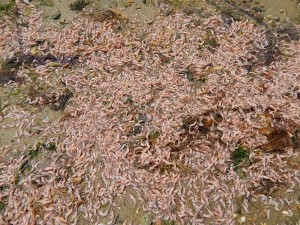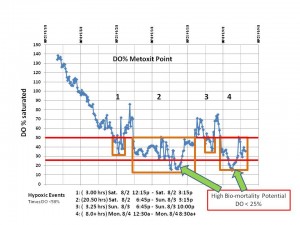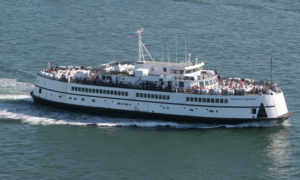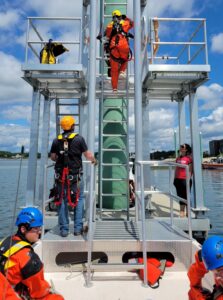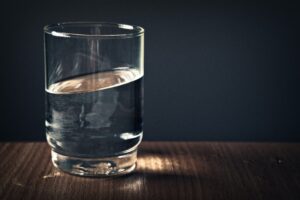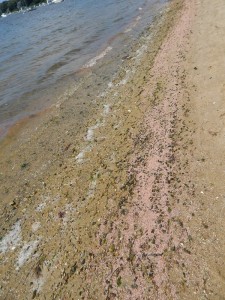
PHOTOS COURTESY WBNERR.
The shore of Waquoit Bay shows dead shrimp extending all along the coastline earlier this week.
WAQUOIT – A pink stripe stretched hundreds of yards along the shores of Waquoit Bay earlier this week. But the colorful mark meant bad news for the bay.
Scientists say low oxygen levels led to a massive suffocation event in the bay resulting in millions of dead shrimp and about 50 dead blue crabs.
Jim Rassman, stewardship coordinator and acting manager of Waquoit Bay National Estuarine Research Reserve said it was noticed Sunday morning and Monday.
“It was literally millions upon millions of grass shrimp, which is a small shrimp that lives in the estuaries around here washed up dead on the beach. People don’t often see them,” he said.
The evidence of low oxygen in the bay, a matter that has been under considerable study for many years, was right at the head of the bay in front of the reserve headquarters and also on beaches of private property owners nearby.
“It was kind of a perfect storm of environmental situations,” he said.
This time of year, water temperatures are warm so they are not as able to hold as much oxygen in general. Algae growth in Waquoit Bay–and a lot of the bays on the Cape have the same problem from a nitrogen stand point–is very high, Rassman said.
Also contributing, there was a lot of algae in the water, especially towards the bottom. Over the weekend, it was rainy and dark. Like other plants, the algae switch from photosynthesizing which produces oxygen to consuming oxygen.
“So on those dark days coupled with the warm temperatures essentially used up all the oxygen at the bottom of the water column to produce a suffocation event,” he said.
In this case, it was a slow developing event. “Over those dark days, it took a while to use up all the oxygen in the water column,” he said.
The reason fish were not killed is that when they sensed the low oxygen, they were able to swim away, Rassman said. But the shrimp and crabs are not as mobile because they are stuck in the algae mats.
“They can’t escape, so they’re the ones that suffer,” he said.
If the low oxygen event had happened quicker, there would have been dead fish as well, he said.
Christopher Weidman, research coordinator at WBNERR, supplied data on oxygen levels in the bay. He confirmed that this time of year, with summer water temperatures at their annual maximum plus several dark and cloudy days spelled a high potential for such an event.
A water quality monitoring station in the center of the bay records water quality information every 15 minutes. The data from that station showed low oxygen levels Saturday, Sunday and Monday morning, which indicates that similar conditions existed in other tidal ponds in Falmouth, Mashpee and elsewhere on the Cape.
He said dissolved oxygen levels in waterbodies on the south side of Falmouth also look very low.
“Perhaps some of lowest and most extensive we’ve seen in the last 9 yrs of the [Pondwatchers] program,” he said.




